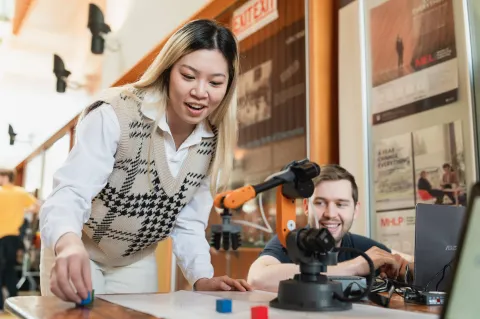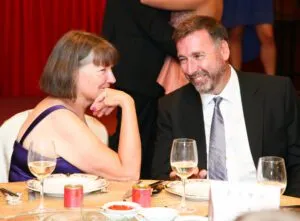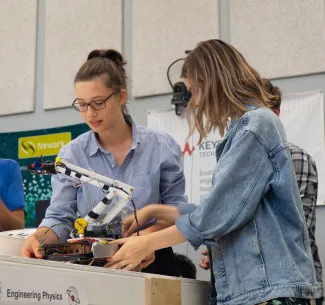Early Internet Contributors Donate to Future Engineers

Few people can claim, as Colin Harris can, to have been part of a team that contributed, in the 1990s, to the evolution of the Internet. But given the complexity of his company’s innovation, many of us may need Google to understand it.
While any online search will attest to the importance of PMC-Sierra’s technological leap, Colin shrugs at this Google-given reality with his characteristic humility. “Most people say our chips provided the early plumbing of the Internet,” he says. “But I could explain what that means if you’d like.”
The plumbing of the World Wide Web—yes, this metaphor is easier to understand than the alternative: the invention of the first OC-12 (622 Mbit/s) S/UNI transceiver microchips. However you choose to describe it, this breakthrough inspired Helen and Colin Harris to recently give $2M to UBC Applied Science, donating $250K to the Engineering Physics program and $1.75M to Applied One, the Faculty’s largest campaign to date. UBC matched both gifts to double their impact.
Applied One, at the simplest level, is a $300-million campaign to design and construct a building that will reinvent research and learning. How? By literally putting engineers, architects and planners in the same room, with the goal of addressing challenges such as inequity, climate change and future “system shocks” like the Covid-19 pandemic.

How will this support impact EngPhys students? “The short answer,” says Andre Marziali, Director of EngPhys, “is that the gift will help us expand our capacity to educate and elevate students.”
Bottom line: “We’ll be able to graduate more engineers like Colin.”
Colin Harris and his brother Ross were the first in their family to attend university. While Colin graduated from the UBC EngPhys program in the early 1980s, Helen studied agriculture at the same time, graduating with a degree in UBC Food and Land Systems (formerly called the Faculty of Agricultural Sciences). Interestingly, two of their three sons also studied at UBC, while their third graduated from engineering at Western University.
That said, Helen, smiling, explains that this particular donation is “more Colin’s than mine,” given his interest in EngPhys and Applied One. Yet the decision to give back to their shared alma mater, she adds, was important to both of them.
“The question always is, ‘Where do you want to put your money?’” says Colin. “There are three things we want to do with it. We want to help UBC keep learning about the world and solving problems—so that’s one. And the second is to help people—that’s number two.”
And family is number three. “We have five grandkids. Hopefully, some of them will soon attend UBC and walk through these halls."
Collaboration also happens to be important, a principle that made both the Engineering Physics program and Applied One appealing. Collaboration is one of the values, in fact, that made PMC-Sierra a veritable force in the pioneering days of the Internet.
THREE YEARS AHEAD OF BELL
The timeline of PMC-Sierra reads like a plot and has many chapters, but long story short, Burnaby-based Pacific Microelectronics Centre (PMC), a division of Microtel Pacific, was spun into a private company in 1992 devoted to manufacturing networking semiconductors. In June 1997, PMC bought its San Jose, California-based parent, Sierra Semiconductor, and changed its name to PMC-Sierra.
Thanks to the innovations of a cadre of UBC Electrical Engineering students, PMC-Sierra revolutionized the optical networking chipset market. This circuit-design success, according to PMC-Sierra, “put the company three years ahead of Bell Labs in its optical transceiver development.”
It also meant their work was incorporated into this newfangled thing called the Internet.
This flagship building will produce great results for the province by putting the best and brightest minds together. Together they’ll work on the biggest issues of the day.
Colin Harris
This is where collaborative thinking enters the story because Greg Aasen, a co-founder of PMC-Sierra, recognized a gap in company knowledge and reached out to telecom engineers across Canada. “We knew a lot about chips but less about telecommunications,” Colin says. “They knew all about telecommunications but less about chips.”
So the two disciplines worked together. “That’s what made the company great,” said Colin. “And the rest was history.”
While PMC-Sierra went to develop microchips instrumental to the development of “Big Data,” Colin left PMC in 2016. Active now in the Creative Destructive Lab (CDL) in Vancouver, located at UBC’s Sauder School of Business, he’s also a board member of several companies involved in various deep-tech disciplines.
All of the companies use “cross-disciplinary” technology—much like the students, staff and faculty who will one day confront global challenges within the cross-disciplinary spaces of Applied One.
MORE TOOLS, MORE SPACE, MORE ADVANCED

Integral to Applied One’s design will be the shuffle of the design, policy and tech disciplines, shared spaces that will provide EngPhys with much-needed access to tools often too expensive for a single program or department to purchase. Think of a water-jet cutter or a smorgasbord of pricey manufacturing technologies.
“Colin and Helen’s gift is fantastic for our students,” says Marziali. “The more resources they have, and the more space they have, the more advanced their projects will be.” And, by extension, their education.
That said, an equally important impact of the $2M gift will be its gift of space. “Everyone wants to see our students engaging with these new and emerging technologies,” says Dylan Gunn, the Director of the EngPhys Projects Lab. “And we just can’t do that without space. It’s that simple.”
Once built, Applied One will bring students together in unique ways, mobilizing future professionals from EngPhys, business, architecture and IT to ensure these and other disciplines are no longer cut off from one another, relegated to separate buildings across campus. This dusty separation, while understandable considering the siloed nature of education in the 20th Century, is hardly a blueprint for change in the 21st.
Applied One will help fix that, colliding methods and pooling perspectives, enabling engineers to learn from designers, architects from policy-makers, and so on. Experiential skills will broaden. Students will learn how to contribute to the big tech advancements of their day—AI or deep learning, for example—just as Colin, early in his career, had a hand in the early development of the Internet.
For this reason, Colin believes that donating to Applied One is “a really good way for alumni to give back. This flagship building,” he says, “will produce great results for the province by putting the best and brightest minds together. Together they’ll work on the biggest issues of the day.”

